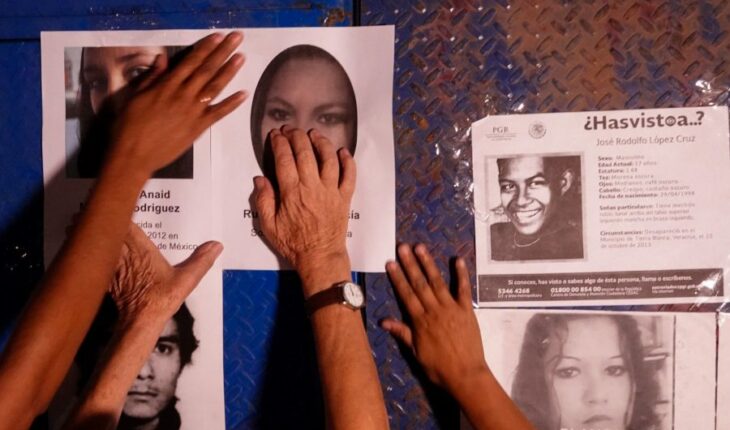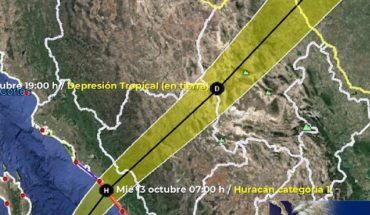Mexico is a country with more than 100,000 disappeared people – according to official figures – and with a search system that has been pointed out as a violation of the human rights of the victims and their families, according to the UN Committee on Enforced Disappearances.
Faced with this reality, relatives of missing persons and activists share advice on what can be done to search for someone, while stressing that no one should have to go through such an experience.
“I’m going to open a thread that I hope no one ever has to use…,” Baruc Sánchez, brother of Wendy Sánchez — a young woman who disappeared in Nayarit in 2021 — wrote last April in a series of messages on Twitter in which he set out his recommendations. Among them, he mentioned tracking on social networks indications of where someone could be not located or contacting as soon as possible the last people with whom he had communication.
I will open a thread that I hope no one has to use, this is in the experience that has allowed me to look for Wendy, what to do in case of disappearance?
— Baruc (@_baruc_) April 12, 2022
For this text, Political Animal He collected the voices of Anna Karolina Chimiak, co-director of the civil organization CEPAD, and Liliana López, member of the Research Group on Social and Forensic Anthropology (GIASF), who gave their advice and reflections derived from their experience of accompanying people with disappeared relatives.
When can I report a person missing?
“A person is considered missing when you don’t know about his whereabouts, about his body, that regardless of the time elapsed and also regardless of whether a crime has been committed or not” Chimiak explained.
A disappearance is different from a kidnapping. “If someone has not contacted you to tell you that they have your relative and has not asked you for favors, money, something in return, then we are not facing a kidnapping. What characterizes the disappearance is that you don’t know anything, you don’t know where it is, you don’t know who has it, nobody communicates with you.” Lopez added.
The specialists emphasized that each case of disappearance is different and, depending on the route or activities of the person, it is how relatives can soon realize whether or not there are traces of their whereabouts.
For example, if a person disappears on the way to work, very soon you will know about their absence. Instead, it is possible that the disappearance of a person in a migration situation will be known until long after it occurred.
In these cases, it is to be expected that the families do not know what to do, since no one is trained to face this type of event. Nor should they feel guilty for not having realized the situation quickly.
The first thing to do, according to Lopez, is to confirm that the person she was not located, as well as collecting clues about who last saw her and, if possible, identifying where she was going.
Where to raise the report?
Chimiak explained that families can make two different types of reports.
A report may be filed with state or local Search commissions. The data of each one can be found on the Internet by typing in a search engine “State Search Commission” or “Local Search Commission”, plus the name of the state or municipality corresponding.
It is not necessary to go in person, so the report can be anonymous. It is also possible to send an email, dial by phone and even, in some cases, those instances receive the reports on their Facebook pages.
From there, commissions should begin an immediate search. Going before them is an alternative for families threatened by prosecutors’ offices or who distrust these institutions.
The other option is to file a criminal complaint with the Attorney General’s Office., either before the Public Prosecutor’s Office or the Specialized Prosecutor’s Office for Missing Persons.
In this case, the complaint must be in person. It can be presented by a legal representative, a family member or an acquaintance. Lifting it can take about a day.
It is recommended that, at the time of reporting, the person who has the most information about the disappearance be present. It is also suggested to use a notebook to write down all the data provided by the prosecution.
In addition, a photograph of the wanted person will be needed, so that the authorities see their physical characteristics.
Starting of the complaint, an investigation folder is opened and the authority must begin the search.
This complaint allows the family to access the Executive Commission for Victim Care, which in turn provides legal advice, medical and psychological care free of charge. Likewise, the complaint also allows a declaration of absence to be requested.
Both reports – the one presented to a Search Commission and the complaint to a prosecutor’s office – can be made simultaneously. To consult specific doubts about each step, CEPAD published this guide.
Re-victimization, delays and omissions
Although the authorities are obliged to do their job, families may run into obstacles. For example, that they find omissions or bad practices.
On some occasions, at the time of filing a report, the authority questions whether the complainant is certain that the person did not leave of his or her will or did not leave with someone else. That is revictimization.
“There is a whole activation of prejudices and sexist stereotypes: if she is a woman, she left with the boyfriend; if he’s a young man, maybe he went farra,” Lopez said.
Revictimization can cause families to desist from reporting amid nerves, fear and uncertainty, the specialists agreed.
Although some people believe that they must wait 72 hours to file a complaint for disappearance, that goes against the same General Law on Forced Disappearance of Persons. That is, a missing person can be reported regardless of the time elapsed.
According to Your rights, a CEPAD guide for relatives of disappeared persons, another omission is that a folder is opened for another crime, such as kidnapping, and not for disappearance.
Therefore, when raising the complaint, the authority must show the document drafted and which will be signed by the complainant. In addition, at all times, the family has the right to access the copy of the case file and review the crimes charged, as well as the progress.
After the report, the authority must grant a search slip. That is why it is important – although not mandatory – to have a photograph of the person being sought.
This file shows an image of the person, his name and personal data, as well as a telephone number of the authority, so that the citizens can contact in case they have knowledge about his whereabouts.
When you have the file, the family can spread it on social networks or other channels, such as media. Only in some cases, the risk analysis determines not to do so because this could hinder the search itself.
Chimiak also stressed that in no case is a disappearance the victim’s fault. “You may have some substance use problem or not, we don’t know; it may be in some other kind of social problem, and even if some of these elements existed, that does not justify in any way that a person be disappeared,” he said.
Make a declaration of absence
Within the legal, administrative or labor fields, there is a gap to know what to do after a person disappears.
For example, the family cannot access the bank account of the disappeared person, stops receiving the salary of the person who does not appear, continues with a housing loan and even problems arise with the guard and custody of minors.
Therefore, it is important that families make a special declaration of absence.
“There is a legal figure that is the result of the diligence of relatives of disappeared persons, it is called a special declaration of absence due to disappearance, it helps us to provide that legal certainty to relatives of disappeared persons,” Chimiak explained.
According to the law, this request can be made three months after the complaint for disappearance made to the prosecutor’s office.
The request can be submitted by the family, a legal representative, the Public Prosecutor’s Office — at the request of the relatives — a legal adviser or any person affectively related to the disappeared person.
To this end, labor and patrimonial data of the disappeared person will be requested, in order for their assets to be protected.
Some benefits of this are that the assets that were being paid for by the missing person through a loan or mortgage are not removed. Also, that medical service continue to be provided to immediate relatives, in accordance with the labor rights of the disappeared person.
Disappearances in Mexico
Those who are looking for their disappeared wonder every day about qPeople disappear. In this regard, the specialists pointed out that it is a phenomenon with various causes.
“There is no single modality that crosses all forms of disappearance in the country, but it is delineated by local and regional contexts. Even within the same territory, the modalities are changing,” Lopez said.
As of May 16, the states in the country with the highest numbers of missing persons are Jalisco, with 14,951; Tamaulipas, with 11,971; State of Mexico, with 10 thousand 994, and Nuevo León, with 6 thousand 2018.
In all of them, there are activities of organized crime groups dedicated to drug trafficking or extortion, although in other entities of the country, such as Tlaxcala or Mexico City itself, security specialists link disappearances with human trafficking.
What we do at Animal Político requires professional journalists, teamwork, dialogue with readers and something very important: independence. You can help us keep going. Be part of the team.
Subscribe to Animal Político, receive benefits and support free journalism.#YoSoyAnimal





